#but the drawing itself does not depict anything dystopian?
Explore tagged Tumblr posts
Text

First look at my New Adult neuropunk dystopian heroine Ika Lehmacher, and the other girl the rebels saved/abducted so that both of them wouldn't be "cured", Sheede Enns.
#ockiss24#OCkiss#OC#own character#wlw#femslash#sapphic#not sure if I should put this in the dystopia tag or not#the novel is dystopian#but the drawing itself does not depict anything dystopian?#for findability on my blog:#Ika Lehmacher#Sheede Enns#Ika/Sheede#Eine Heilung vom Anderssein
12 notes
·
View notes
Note
tell us about your disdain for Fahrenheit 451 and how it fails as a piece of dystopian literature by sanitizing the historical content it draws from
I’m an English teacher, so my response is long. Therefore, I have put it below the cut!
My main issue with F451 is partly with how the text is taught and the failings of the text itself.
1) The text is usually taught from the viewpoint, “What if we lived in a world without books?”
Well, historically, possessing books was a sign of privilege. People who owned books had the money to buy books. Throughout time, our knowledge didn’t originate as text, or if it did, it wasn’t in book format (visual depiction such as a calendar or drawing). Books are not the only valid form of knowledge, and how the novel is taught, the teachers reify books. if there were no books, there would be no knowledge! Wrong.
2) Bradbury himself draws inspiration for the destruction of books/knowledge from the actions of the Nazis. He establishes an authoritarian government in his novel as well.
Book burning, the destruction of knowledge, is supposed to be viewed as just about the worst thing you can imagine--opening the book with it is supposed to shock you. Except Bradbury ignores the elephant in the room from the historical content he draws from: genocide.
3) The society the text depicts falls apart when pressed with questions.
What happened to those in society who pass their knowledge generationally through storytelling?
Why is Faber still alive if he was a college professor? Shouldn’t he have been killed because of his danger to society and his predisposition toward instructing others on critical thinking?
4) This text is presented as a horrific dystopia that teachers find comfortable teaching precisely because it doesn’t tackle issues like race, class, ethnicity, etc.
The text is written from an incredibly biased privileged Eurocentric, Western perspective which passes itself off as an objective line of questioning following the hypothetical scenario: What would happen if books were burned and America were controlled like in Nazis Germany? You cannot follow this line of questioning without inquiring about the fate of cultures who do not fit the expectations of the government. There isn’t even any mention of assimilating to the mainstream culture in order to survive.
5) The protagonist is the central failure of the text.
So if in this society, those who passed knowledge through an oral storytelling tradition were forced to enter assimilation programs or be murdered (or some other euphemism a la “going to Urinetown” via the popular dystopian musical Urinetown). Following someone whose family constantly lives in fear of being discovered, of being murdered, of having to navigate preserving one’s heritage all the while surviving the state of American society documented in F451, THAT is moving.
Following a privileged man (presumably white though the book doesn’t mention this; however, if this were some progression of America in the 1920s to whatever Bradbury created in his novel, then it’s very unlikely the protagonist would be anything other than white), through his discovery that wow literature is important and books are so important and worth risking your life for. Why does Montag get to survive and not the people who are desperate to survive, to preserve their culture, to save their way of life? Or does Bradbury just fail to realize those people exist?
And what about that woman who dies for her books? Wouldn’t it make more sense for her to survive and pass the knowledge about those books on to others? Knowledge doesn’t burn from your brain when the books are destroyed.
9 notes
·
View notes
Text
Cramp’s Comic Recommendations For Fans Of Classic Rock And Co.
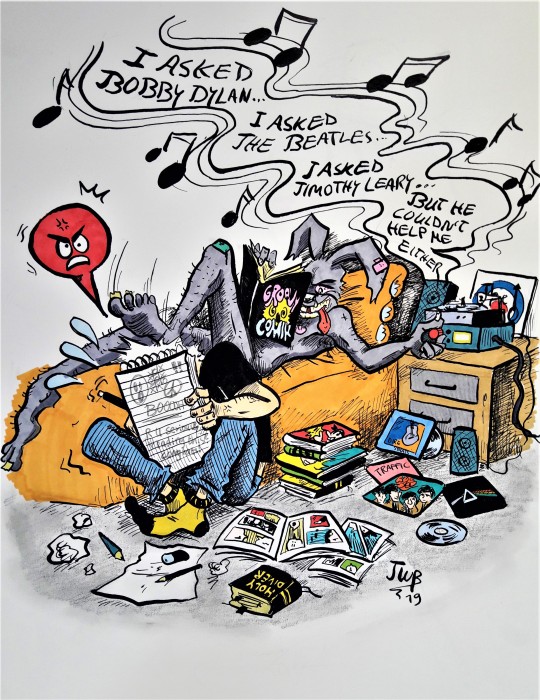
Allright here we go. This is my current list of comics/manga/graphic novels you might enjoy if you’re into classic rock. Before we get started I’d just like to let you all know:
- This list is far from being complete. I’m sure there are many more groovy comics out there that I’m simply not aware of yet so if you have any suggestions feel free to add them :)
- I know I said “Classic Rock” but some of my choices may drift into other musical directions
- Needless to say I do not own any of the following images. They all belong to their rightfull owners and I’ll use them as visual reference material only.
- Sorry for eventual misspelling
Let’s go ^^
1. Bob Dylan Revisited
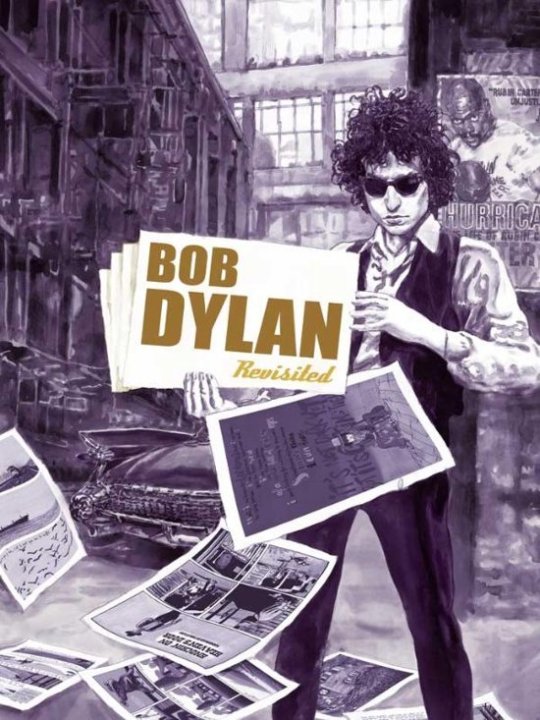
Let’s start with an obvious choice. This is a collection of 13 well-known Dylan Songs, each of them graphically interpreted by a different artist. The most striking feature therefore is the high variety of different art styles. Some of them are cartoony, some are very abstract while others are almost photo realistic.
Dylan’s mesmerizing lyrics have always been inspirational and these beautiful depictions truly are a sight to see.
Including works of Thierry Murat, Lorenzo Mattotti, Nicolas Nemiri, François Avril, Jean-Claude Götting, Christopher, Bézian, Dave McKean, Alfred, Raphaëlle Le Rio, Maël Le Mae, and Henri Meunier, Gradimir Smudju, Benjamin Flao, Jean-Phillippe Bramanti and Zep.
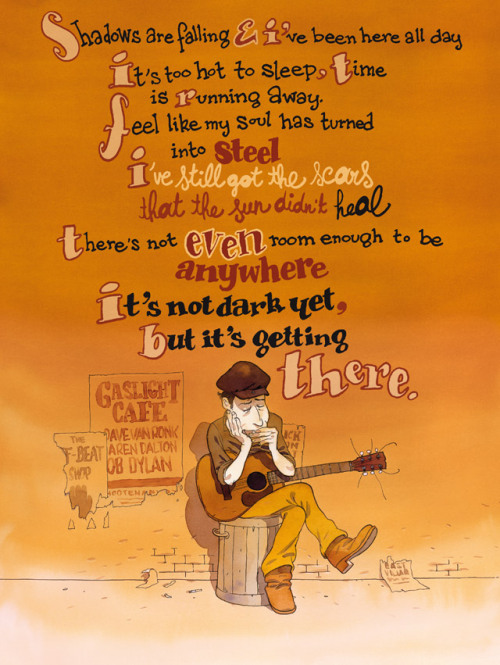
Zep’s take on “Not Dark Yet”
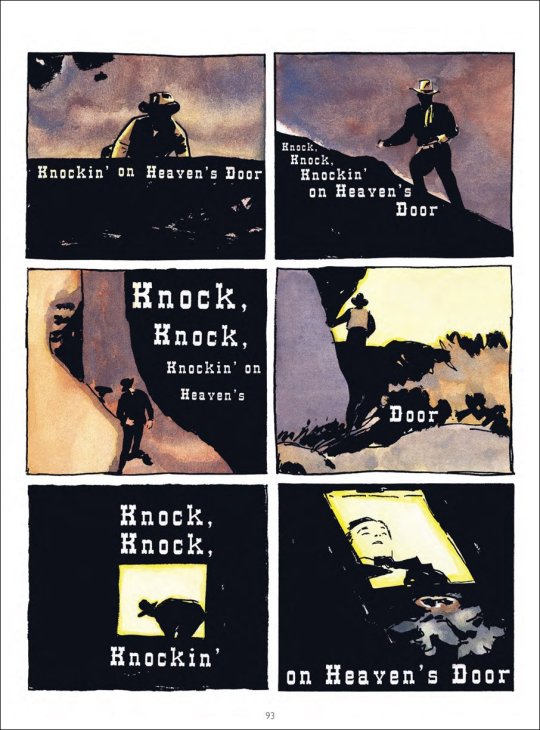
Jean-Phillippe Bramanti’s interpretation of “Knocking On Heaven’s Door”
Definitely worth checking out not only for Bob Dylan Fans.
2. Baby’s In Black” by Arne Bellstorf
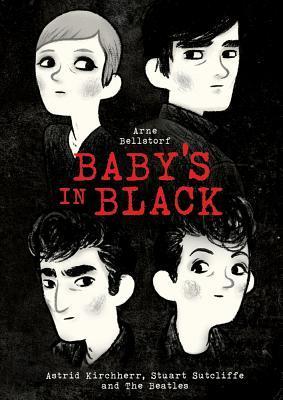
I’ve seen several people in the Beatles fandom complain about the lack of Stuart Sutcliffe material when it comes to early Beatles history.
Well, here it is: a graphic novel that focuses on the relationship between Stuart Sutcliffe and fotographer Astrid Kirchherr who took the very first professional photos of the Beatles during their time in Hamburg (1960-61).
Told mostly from Astrid’s point of view this comic presents itself in a grey and melancholic tone that fits the rather sad story. Bellstorf’s drawings are simplified and charming (they remind me of early sixties children book illustrations which suits the setting’s time period)
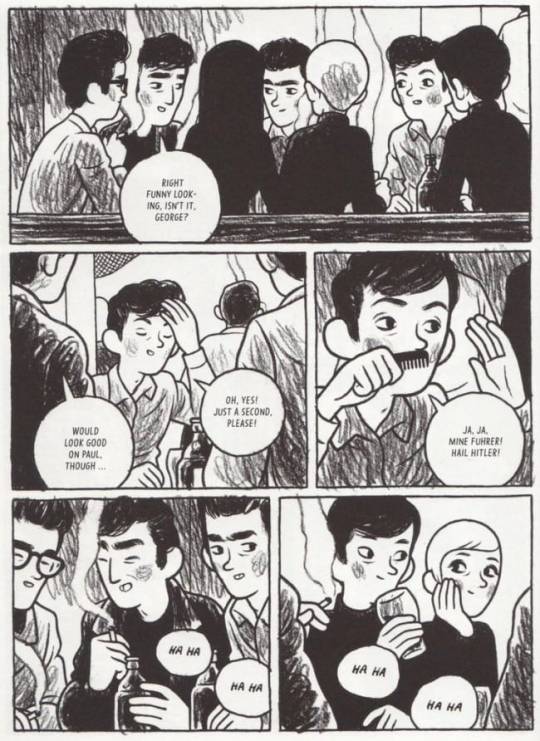
If you’re interested in early Beatles history (especially their Hamburg days) you should give this one a try.
3. Blue Monday by Chynna Clugston Flores
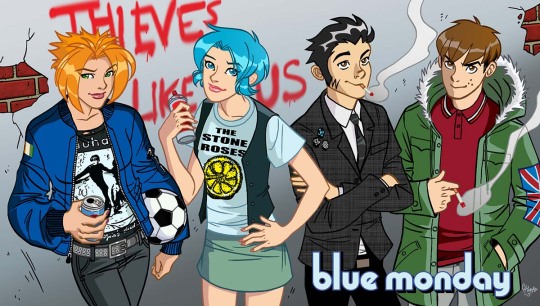
I really wish I had known about this amazing comic series a few years earlier, not only because this is a slice of life/coming of age story with teenage characters who are actually likeable and relateable but also because “Blue Monday” is an overall highly entertaining depiction of early nineties teen culture/rebellion in an American suburb that comes with a lot of references to Britpop, mod culture, Buster Keaton movies and Adam Ant (to name only a few).
To quote the author herself: “It’s like Archie on crack, with cursing and smokes”.
The art style of Chynna Clugston Flores is very vivid and expressive and has a certain stylistic touch of anime/manga (like a lot of comics from the early 2000s). I also really enjoy all of the graphic fashion details in this one. Plus, this is the first comic with it’s own soundtrack and that’s always a nice bonus.
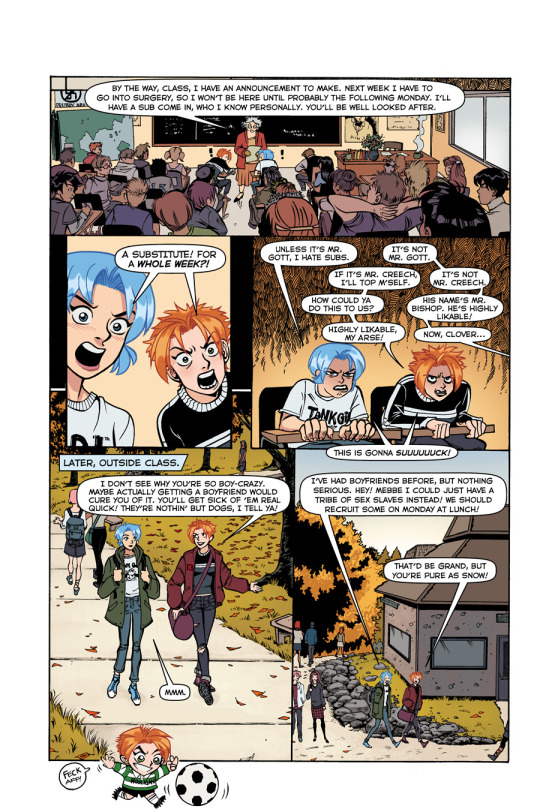
I’d recommend “Blue Monday” for fans of Britpop, Punk, New Wave and early 1990′s culture.
4. Punk Rock And Trailer Parks by Derf Backderf
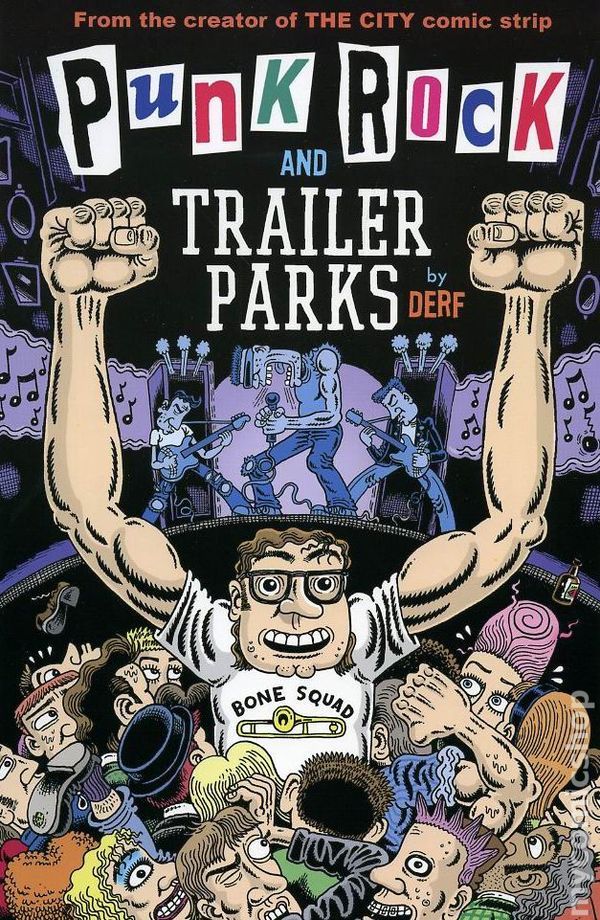
Another story about growing up in American small town madness, this time set in 1980s gritty Punk subculture of the former rubber city of Akron, Ohio. Protagonist Otto who likes to refer to himself as “The Baron” becomes fascinated with Punk after attending a Ramones concert. He meets several Pubk icons (thus as The Clash, The Plasmatics, rock journalist Lester Bangs and many more) and becomes someting of a local punk star himself.
Derf Backderf (who is best known for his highly acclaimed graphic novel “My Friend Dahmer” and his Eisner award winning comic “Trashed”) created a comic that is as “raw and dirty as punk itself”. His art style is an unique combination of expressionism, underground cartoons and punk magazines.
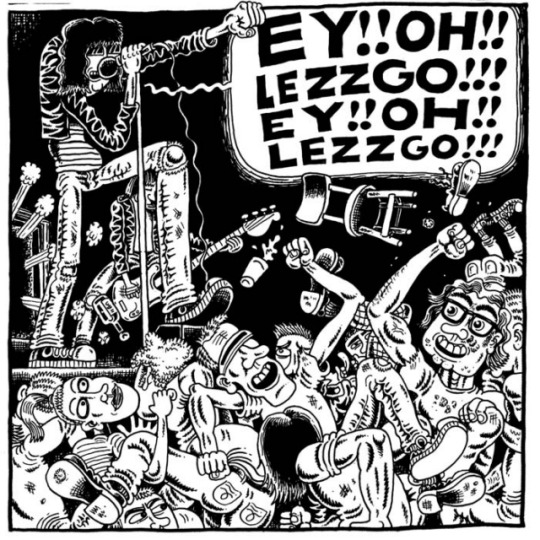
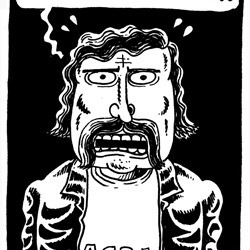
“Punk Rock And Trailer Parks” is a must-have for punk fans (especially if you’re into The Ramones and The Clash. It made me a huge fan of both of them).
5. “CASH - I See A Darkness” and “Nick Cave - Mercy On Me” by Reinhard Kleist
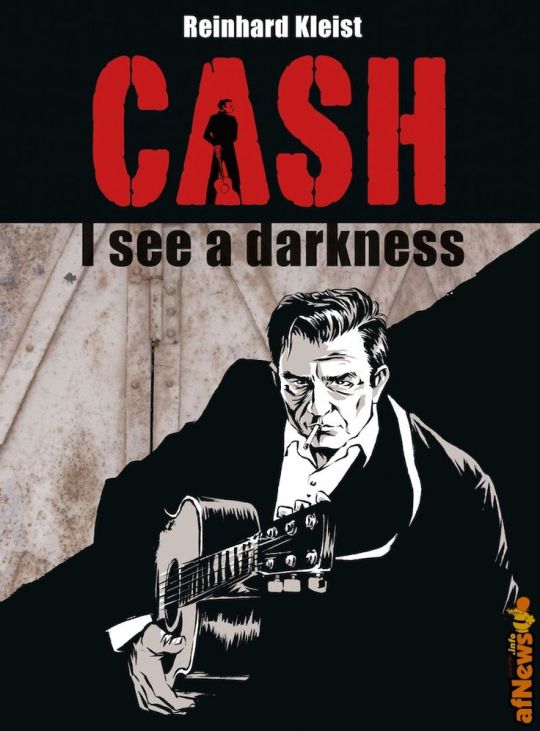
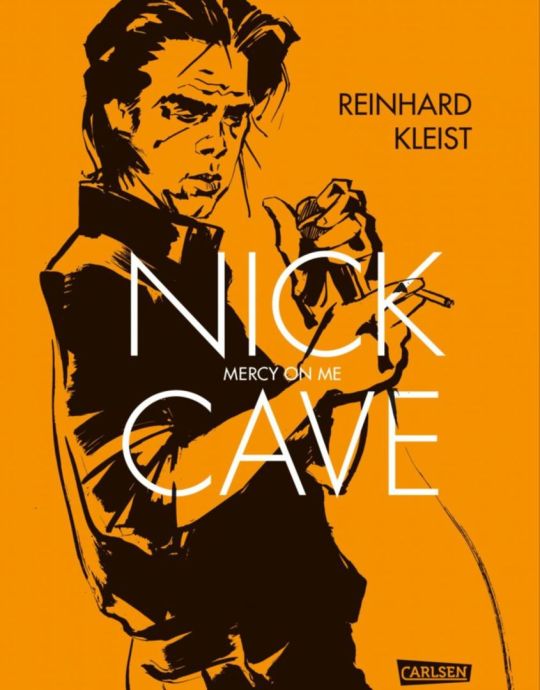
Two biographical graphic novels by Reinhard Kleist, both of them tell the story of a fascinating personality in rock history and both of them are incredibly well drawn. Kleist’s art is full of life and movement and very atmospheric due to his impressive use of stark contrasts.
I personally love his semirealistic way of drawing people and I’d highly suggest you to check out his other works too. He made a lot of biographical comics that really amazed me.
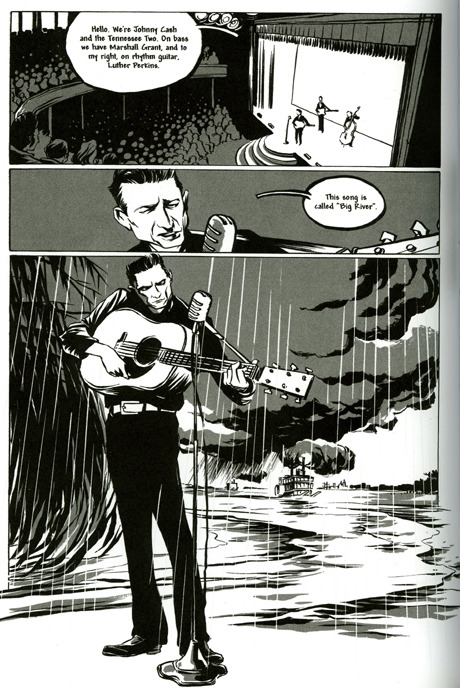
CASH

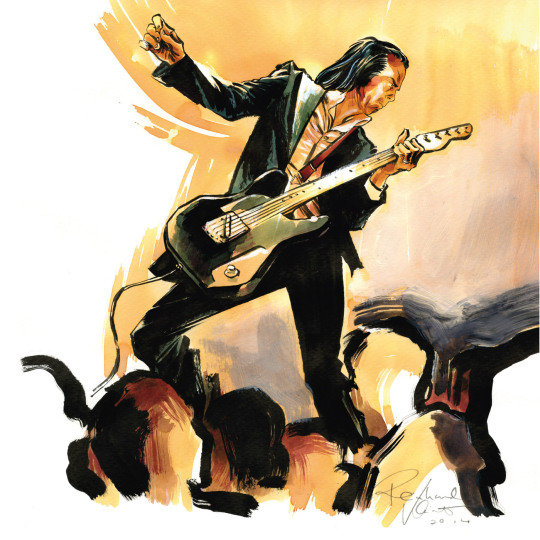
Cave
Definetly worth reading. Not only for Johnny Cash and Nick Cave fans.
6. Nowhere Men by Eric Stephenson, Nate Bellegarde, Jordie Bellaire and Fonografiks
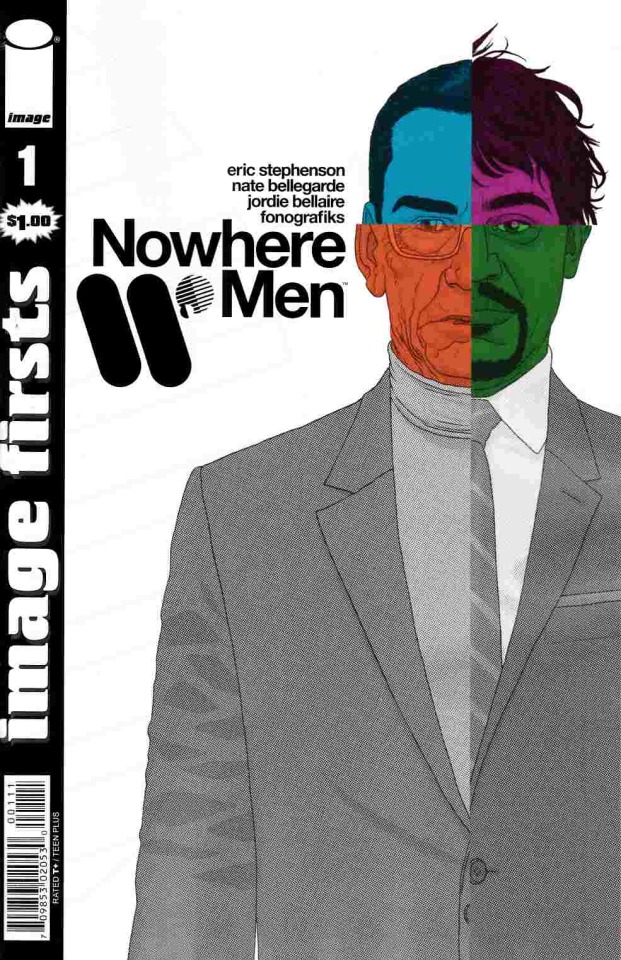
I talked about this one a while ago but I’ll gladly do it again since it’s just too cool. “Nowhere Men” is set in an alternative past/present and future where scientists became as popular as pop stars (catchphrase “Science is the new Rock n` Roll”) but somewhere along the way something definetly went wrong.
The hype of science shares obvious similarities with the beatlemania of the 60s and the founding of Apple back then. Furthermore, the characters are partly inspired by well-known personalities of Rock history. There are many more or less hidden nods and references to musical popculture wich is why I put it on this list.
Nowhere Men is a thrilling sci-fi dystopian that requires an observant reader because there is a lot of jumping back and forth i time and inbetween information. The art style is realistic and full of very vibrant colours.
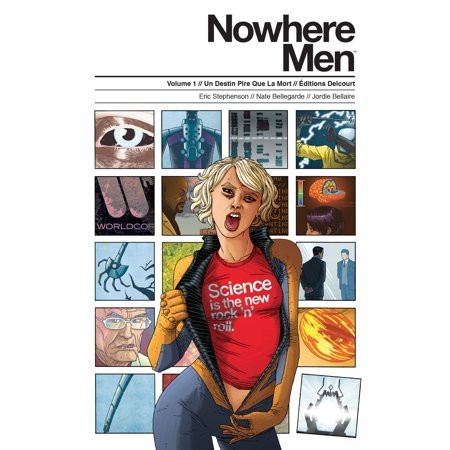
I found myself reading this multiple times to get all of the details in the world building. A thoughtful and brilliant writing indeed.
7. P.I.L. by Mari Yamazaki
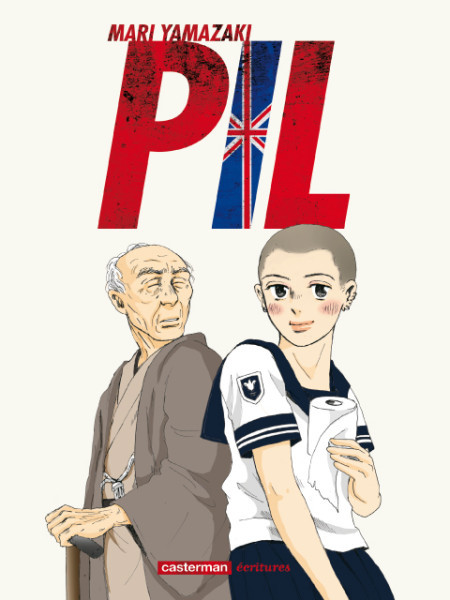
Japan 1983: 17-year-old Nanami couldn’t be more frustrated. Her grandfather loves to spend all of their household money on useless luxury junk and her strict school criticizes her messy hairstyle. Caught between teenage rebellion and responsibility as she tries different side jobs to earn at least a little bit of money, Nanami also has a thing for punk music and overall everything originated from England.
P.I.L. tells the story of conflict between two generations who aren’t as different as they might seem. Sometimes funny and heartwarming, sometimes with a bit of drama this is a charming slice of life/ coming of age josei with a more simplistic but aesthetical pleasing art style.
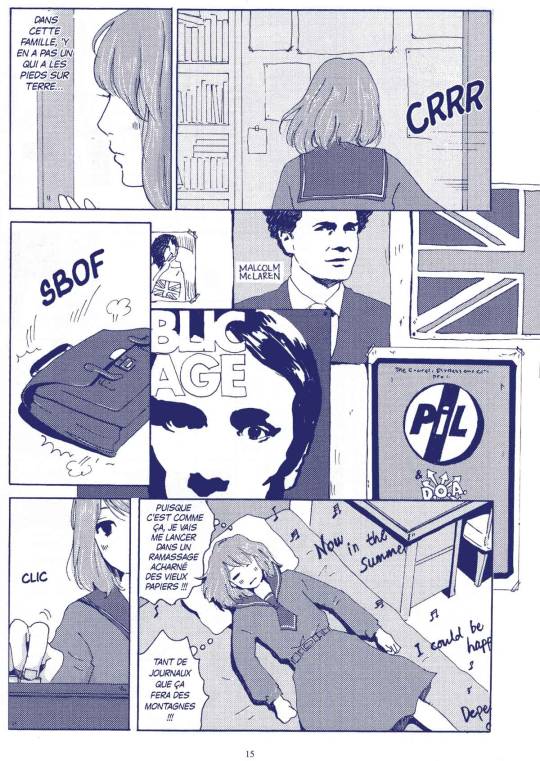
as the title might suggest, Nanami is a big fan of P.I.L. and other bands of the punk, neo punk and new wave movement such as The Stranglers and The Killing Joke
8. Yellow Submarine by Bill Morrison
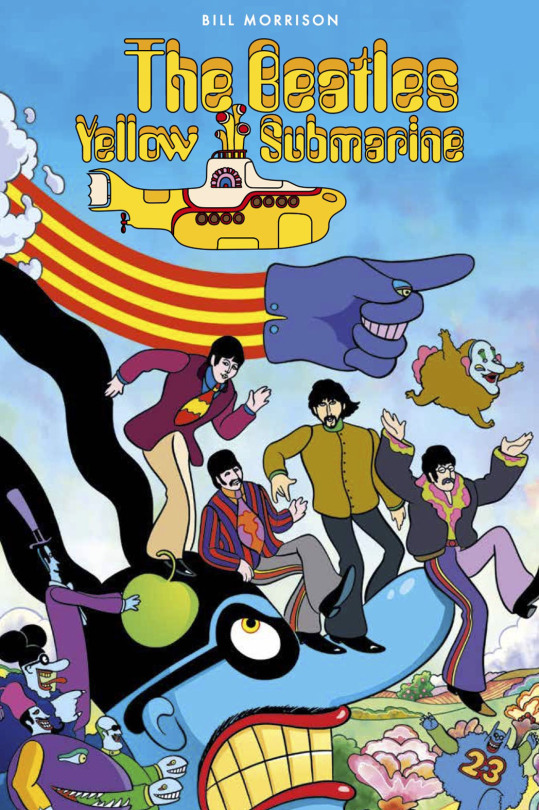
A comic adaptation of an animated film such as Yellow Submarine? Yeah, I was skeptical at first too but hear me out: This is really great. Morrison did an amazing job at capturing the trippy and psychedelic feeling of the legendary Beatles film. As the 1968 film used the medium of animation as an actual form of art to accomplish things only animation can do, Morrison did the same thing and used the advantages of the comic medium to accomplish things only comics can do. And it works. It really works.
Every single page of this colourful book has a different panel layout. Some of them are so beautiful and creative that I’d love to have a full-size poster version of them :’D
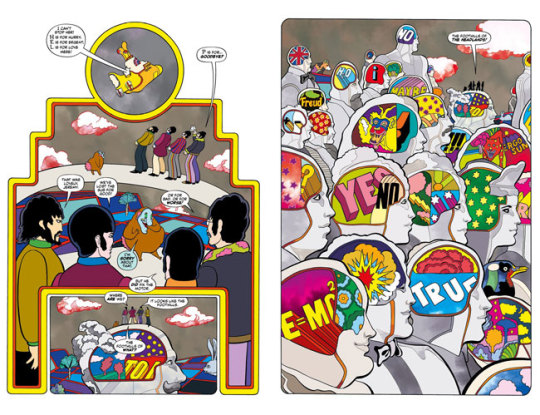
If you liked the film, if you love the psychedelic age, you’ll probably like the comic too.
9. In The Pines by Erik Kriek
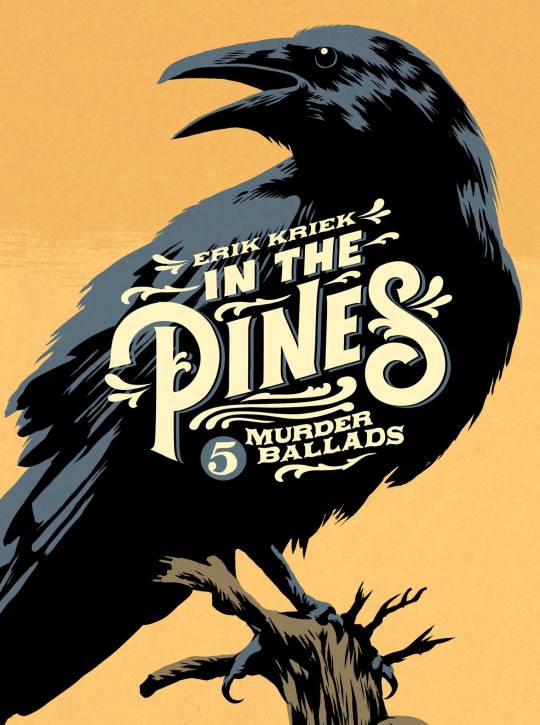
“In the pines, in the pines, where the sun never shines...”
5 Murder Ballads, some might call them dark Country Music, each of them beautifully illustrated by Erik Kriek. Atmospheric, dark and gritty and always on point to match the spine-chilling western-like storytelling of these ballads, great for fans of horror literature a la E.A.Poe.
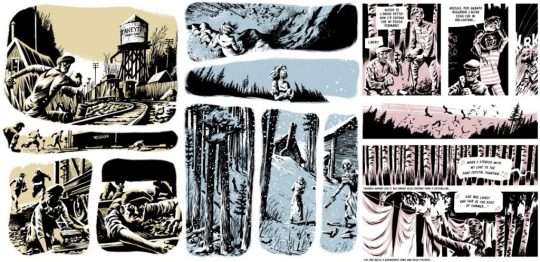
10. Andy - A Factual Fairy Tale by Typex
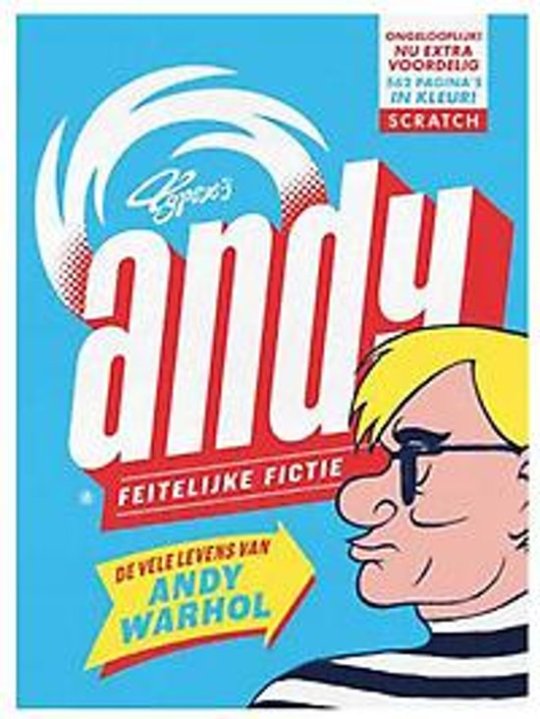
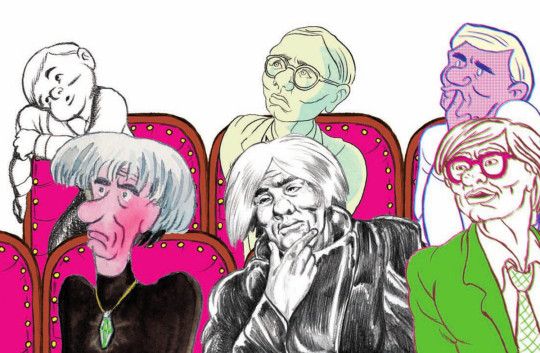
Allright folks this is it:
Typex’s “Andy” is by far one of the best comics/graphic novels I’ve ever red. It defenitely is my personal favourite reading of 2019 (and tbh I kinda doubt anything will top this anytime soon)
This is more than just a biographical take on of the most enigmatic pop-art artists of 20th centuary’s America, this is a portrait of the 20th centuary itself. There are so many references to art, history, literature, music and more that I could fill a book counting them all. And of course this is a monument for the medium of comic itself. Typex really managed to show what comic’s are capable of (At this point I’m really sorry I can’t explain it better I’m not good in writing stuff like this yet...)
Visually one of the most appealing things are the different art styles Typex manages to pull off so well for every chapter in Warhol’s life because each of them are a mirror of their zeitgeist. The introduction of Warhol’s childhood during the 30s is drawn in a cartoony style of old news paper comic strips. The chapter of 1967 has a psychedelic edge. The chapter of the early 60s shows similarities with the works of Roy Liechtenstein
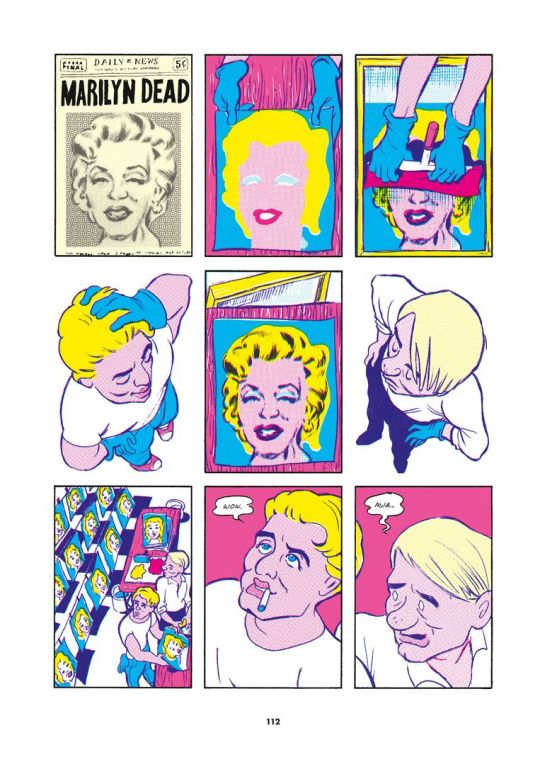
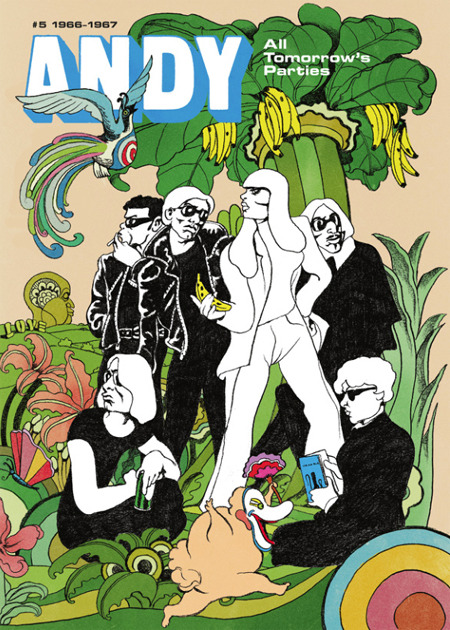
So many icons from the 1930s-1980s have a cameo in this graphic novel it’s just amazing. If you’re even remotely interested in anything of this time period you’d definitely should read this. (seriously, READ THIS). But at this point I’d also like to mention that this comic does not shy away from showing very explicit content and sensetive topics (please keep in mind this has a mature rating for a reason)
Yeah so I couldn’t give this piece of art enough praise. It is absolutely brilliant, a masterpiece in every sense and word.I wasn’t too aware of Typex before but appearentely he also did a graphic novel on Rembrandt. I’m gonna read this too.
Some honorable mentions:
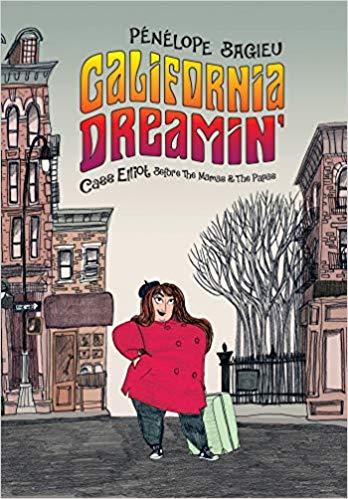
California Dreamin` by Penelope Bagieu
I haven’t red this one yet so I can’t say anything more about it. But I wanted to let you know that a graphic novel about the life of Cass Elliot exists.

Before Watchmen: Silk Spectre by Darwyn Cooke and Amanda Conner
One of the prequels of the legendary “Watchmen” by Alan Moore and Dave Gibbons. It’ “only” an honorable mention because you’ll have to be familiar with the Watchmen universe to fully get all of the story. This prequel focuses on Laurie Jupeczyk, the second Silk Spectre and her own adventures during 1967, the summer of love in San Francisco.
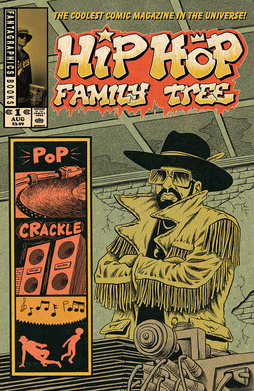
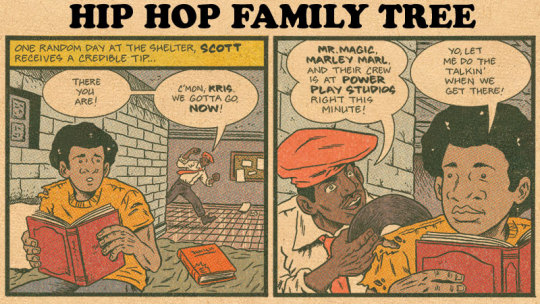
Hip Hop Family Tree by Ed Piskor
Another one I haven’t fully red yet, but so far I’m loving it. It basically tells the history of Rap and Hip Hop from the early 70s to the mid 80s. The art style is intentionally old-school wich really fits it’s tone and setting.
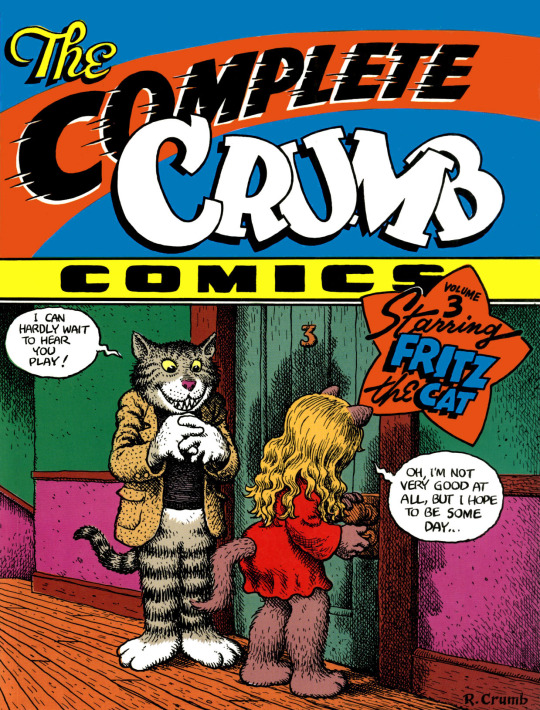
Fritz The Cat by Robert Crumb
I suppose I can’t make a list like this without at least mentioning an absolut icon of the underground comix movement. Crumb created the adventures of this nasty junky cat during the 60s. Fritz can be seen as a satirical mirror of counter-culture’s zeitgeist.
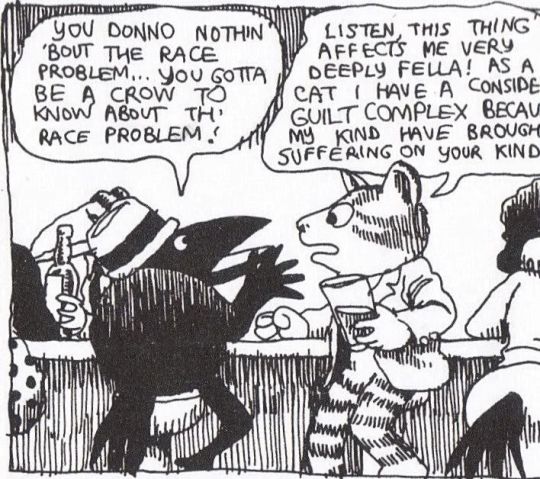
and speaking of Crumb, his “Heroes of Blues, Jazz and Country” trading cards are neat too...

allright that’s it for now. like I said, if you have anymore suggestions, feel free to add ^^
#long post#Cramp talks#classic rock fandom#comic#thierry murat#lorenzo mattotti#nicolas nemiri#francois avril#jean-claude götting#christopher#bezian#dave mckean#alfred#raphaelle le rio#mael le mae#henri meunier#eric stephenson#Nate Bellegarde#jordie bellaire#fonografiks#ed piskor#erik kriek#derf backderf#arne bellstorf#penelope bagieu#mari yamazaki#robert crumb#typex#reinhard kleist#chynna clugston flores
41 notes
·
View notes
Note
I know I've seen you guys post about how shipping incest is okay, but I don't think I've heard much of your views on shipping pedophilia/age gaps/loli/shota/etc. those kinds of things?
When it comes to incest, I think that it's absolutely fine to ship it, and I also think it's fine for two consenting adults to engage in consensual incest in real life - I hate that people can still get absurdly long prison sentences for completely consensual sex (heck, I hate that people can go to prison at all for consensual sex between adults).
You can't really ship pedophilia, since that means "an attraction to children", so I think that what you mean is minor/minor, minor/adult, minor/self insert, and those kinds of ships? In which case I think that it's totally fine to ship that. However, when it comes to reality, I mostly agree with the age of consent laws in my country, which is 16 years-old but with some caveats - anybody 12 or under can never give consent, and it is always illegal to willingly have sex or sexual contact with them; if you're 18 or over it's illegal to willingly have sex or sexual contact with somebody aged 15, 14, or 13 unless you had reason to believe they were 16 or over (so it's not your fault if somebody deceives you, rapes you, etc); it is illegal to pay for or sell sex with somebody 17 or under (or to take, sell, distribute, etc, sexual imagery of them); it is illegal to have sex with somebody 17 or under if you're in a position of care over them (ie a teacher, power of attorney, police officer, etc). By "mostly agree", I mean that I take issue with some sections of the law using gendered language and gendered definitions of rape (which is a problem throughout my country's law), and I disagree with any potential criminalization of teens who take or share photos of themselves (I don't think that they should take or share those photos though, I just believe that it's wrong to criminalize them for doing so), and I think that somebody 17 or under shouldn't be able to get married, and a 17 year-old and a 13 year-old does not sit right with me (there should be some kind of age-gap based system when it comes to that second section regarding those 13, 14, or 15 years-old, possibly something like up to 3 year gaps being okay when one or more party is 13, 14, or 15, with caveats for situations involving rape and/or deceit). Consensual incest between adults harms nobody, so it's fine in fiction or reality, but sex with children does harm them and is not okay outside of fiction... but anything, even that, is fine in fiction.
Like incest, age gaps are fine even in reality (provided all parties can and do consent), and are completely fine in fiction - I find the insistence that any power dynamic is abusive to be incredibly dismissive of the mechanisms of abuse; a power dynamic can be used to abuse but it isn't necessarily abusive itself.
Loli and shota are illegal where I live, which I think is absurd - they are drawings, fiction, just lines on paper, and should not be illegal at all (what's doubly ridiculous about it is that it's illegal to draw a 17 year-old... somebody who you could legally have sex with). It's infuriating because charities that should be protecting real, living children waste their money rallying for these laws.
The TL;DR version of my opinions is that literally anything whatsoever is okay in fiction, and should always be okay in fiction... if we criminalize fiction (as the obscenity laws in my country do) then our society is crap, our laws our crap, we live in a dystopian hellscape, and we haven't left the Victorian era. But I also think that almost anything is okay between consenting adults, so there are some things that antis are against in fiction (like incest) that I'm even totally chill with in reality.
Side note: Please remember that the other mods do not necessarily agree with me, and I don't represent every single mod when I speak - I only speak for myself. Also, I put "intentionally and willingly" before, because "intentionally" is the wording that the law uses, but I decided to use just "willingly" for the purposes of this post, because intentionally has different connotations colloquially than it does in law and I don't wanna be misconstrued (ie being a victim of rape doesn't make you a criminal, or at least it shouldn't... but courts and laws can be weird and messy). It's also illegal and should be illegal to aid in - by soliciting or otherwise enabling - child abuse (but that section was already getting really long and I ramble on too much). I also view familial relation as a position of care, therefore meaning that I would say that both parties should be 18 or over regarding incestuous sex (informed consent should be given and no coercion should be involved... obviously, otherwise that's rape in any situation). I think that prostitution, porn, and sex work should be legal as long as all parties are 18 or over, sober, and give informed consent. Please don't view this as an exhaustive list of my issues with UK law or an exhaustive list of my opinions on law, consent, or fiction - I have a lot of opinions, from strongly held ones to still forming ones. Sorry that I keep tinkering with the wording - this is a topic that you just know someone's gonna misinterpret you on as much as they can, so I'm trying to word it as clearly as I can (if you do take issue with some wording, please ask about it before going off, hopefully we can avoid misunderstandings and have a reasonable conversation if you do disagree with me on this, admittedly very heavy, topic).
You can read up on the age of consent laws for the UK here: https://www.legislation.gov.uk/ukpga/2003/42/contents
I've talked more about the UK's obscenity laws here: http://eeveelutionsforequality.tumblr.com/post/184095555707/a-fictional-depiction-of-an-illegal-act-isnt
I've talked more about my opinions on incest here: http://eeveelutionsforequality.tumblr.com/post/184006728027/cookingwithroxy-someoneintheshadow456
You should always research your local laws.
~ Vape
80 notes
·
View notes
Text
“Stalker” and Mise-en-scène
Stalker (1979)
One way to define mise-en-scène: everything which is in front of the camera. Mise-en-scène can be understood as an assemblage of people and objects which constitute the scene or situation of the cinematic world. Mise-en-scène functions by mimesis in the depiction of worlds real or imaginary, such as Georges Méliès’ painted backdrops in Journey to the Moon, or the more subtle construction of spaces within studio back lots characteristic of Hollywood Films. For instance in the film Casablanca, while the dialogue provides constant reminders that the film takes place in Morocco during World War II, the action was shot on plain-looking sound-stages. On another level of abstraction, one real-life location can be used to stand in for another, as a film shot in Vancouver might "take place" in New York. The truth-value of this visual world may not matter to us unless we are familiar with the location depicted, or if we are seeing a documentary or other film where truth-claims are called into question. But in these cases and others where we feel a "gap" in the representation, the mise-en-scène can become conspicuous. I argue that the mise-en-scène in the film Stalker is deployed in this way, to question the truth-value of its particular fictional world. Stalker takes place in the real world which contains one fantastical "Zone," and the mise-en-scène does the work of suspending our disbelief as to the Zone's magical properties.
Stalker was filmed in an abandoned power plant in Estonia in the 1970′s, and thus we need to consider the Cold War historical context. It looks like a "Soviet" power plant because Estonia was of course within the borders of the Soviet Union. Without knowing this information, one could still guess that we are looking at an abandoned factory of some kind out in the real world, with flora and climate similar to Russia. But if we possess this additional knowledge of the film's production, it does make a difference in how we interpret it. In the film, the power plant and its environs is named the Zone, where a meteorite or UFO has crashed and brought strange new phenomena in its wake. The Zone is a place which is shaped by the consciousness of the people who venture there, and the Zone can either "punish" its trespassers with death or grant them wishes. Of course, there is no way we could film such "magic" and prove its existence. Further, the problem of representation becomes more difficult if a space possess magic power, rather than a single entity or object. Even if we could "really" film this phenomenon, it may not have a recognizable form, or we may not have any visual proof as such. And indeed there are no flashy special effects in this film, and there are no moments where one thing is disguised as anything else. In this sense, Stalker is like The Blair Witch Project. We suspend our disbelief and "witness" the supernatural even though this is not manifest by any visual facts, but rather through acting, as well as systematic defamiliarization of the real world locations.
The film is structured in a way which recalls The Wizard of Oz through its color-coded passage from the real to the fantastic. In summary, three men known as the Stalker, the Author, and the Scientist travel to the Zone in order to make their wishes come true. The Stalker is a man who has intimate knowledge of the Zone, and guides the others through it. They begin in an urban center, which is filmed entirely in sepia tones. There are consistent patterns of decay, corrosion, leakage, and other forms of entropy throughout the film. The director Andrei Tarkovsky famously favors long takes, so that the viewer has more time to focus on the details of the space. Following Andre Bazin's thesis on Italian neorealism, we can argue these shots provide us with both a plentitude of space, as well as a surplus of time in which to contemplate the contours of the narrative world and posit our own interpretation of events. An early example of such a shot focuses on the back of the Stalker's head. The shot is symmetrical in that the back of the head is positioned directly toward the camera, centered in the frame. The man is also well-lit so that our eyes can trace the contours of various textures carefully. His blonde buzz-cut hair is a formation of porcupine-like quills, below which is a frayed cloth scarf, below which is a tweed jacket with its lattice of innumerable stitches. Another shot inside the Stalker's house shows the kitchen in a panorama, with an assemblage of rusty stove, kettle, ladle, and other objects carefully arrayed. Taking in this domestic inventory reminds me of the kitchen sequence in Umberto D where the maid solemnly conducts her morning ritual. In the shots within the town bar, the rough wooden floor appears wet and slippery, and the concrete walls have a worn skin-like appearance. As our heroes escape from the town, the action unfolds in a high contrast film noir montage. The pervasive spotlights, barbed wire, and tanks are shorthand for a dystopian police state. In these spaces, the abundance of flaws, fissures, and frays draws our eyes back and forth across the frame in an ever-increasing number of saccades.
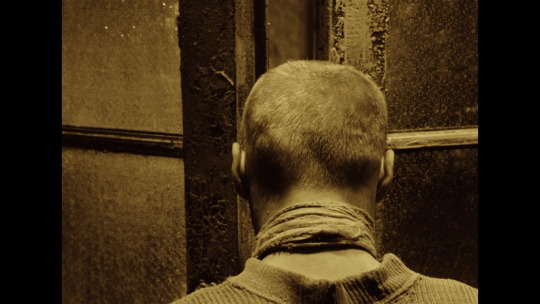

Once our heroes reach the Zone, the color palette changes from sepia to full color. The Writer falls asleep while riding on the electric cart into the Zone, waking up to a world of color. This suggests that the events which occur in the Zone could be a dream, or that the difference between the real world and the Zone is just as dramatic as the difference between waking and dreaming. Establishing wide shots of the landscape, a field littered with tanks, and the approach to the power plant are composed like Romantic era paintings, which emphasize the natural beauty of the surroundings. Several times in the film, characters will suddenly wince, turn away, or fall to the ground under the influence of the Zone's power. The Stalker scolds his companions for failing to "respect" the Zone. However none of the characters are ever granted any clear punishments. At worst, the men are gripped with existential terror. Witnessing these psychological attacks provides our only "evidence" that any supernatural events are taking place. The supernatural qualities of the Zone are also suggested by the eerie nature of the real-world settings. The abandoned buildings are derelict and overtaken with verdure, providing imagery which brings to mind binaries such as nature/technology, past/future, and peace/war. The spaces within the power plant are damp, dark, and ominous. One particularly effective location is the underground sewer tunnel, seen as an inky blackness interrupted with patches of brilliant light streaming through openings above. The room filled with sand dunes is another memorable example. The regular pattern of evenly-distributed dunes is unmistakably man-made, thus uncanny. This approach of "natural assemblage" or of using natural materials in a manner of collage is one of the film's major innovations.
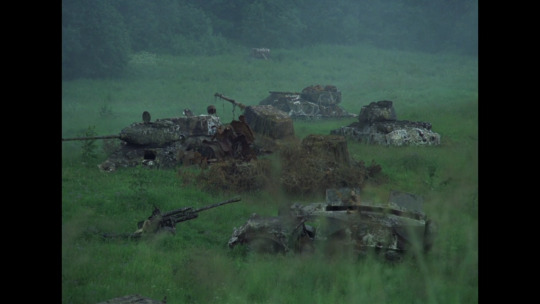
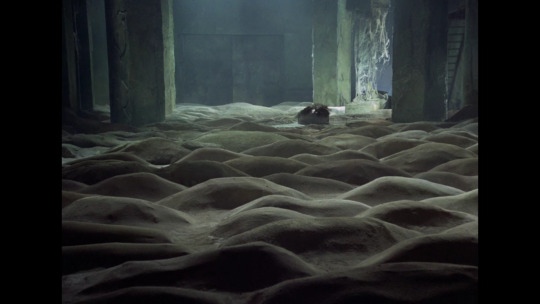
One particularly enigmatic shot in the film fully realizes this concept of "natural assemblage." This is an overhead shot of a small pond, which slowly moves upward. While this occurs in the middle of the film, the shot is in done in sepia as we saw in the first act. In this murky shallow water, we see an array of objects passing by. At first these objects seem to be random detritus, but their symbolic nature soon becomes evident. We see floor tiles, springs and gears, snails, a bucket of fish, a gun, and a Catholic icon pass by. The ruins of a civilization can be figured as a pile of dead signifiers. Here the grand human obsessions with industrialization, religion, and war are reduced to mere trash floating in a stream. Much like the nondiagetic montage sequence of religious icons in Sergei Eisenstein's October, this shot is excessive. It is narrative excess, in the sense that we are gazing at mere objects which do not tie into the narrative action. But it is also excessive in its cryptic nature (why are so many diverse objects presented to us in sequence, like a rebus?). Without any narrative motivation for the shot, we must contemplate its meaning as the stream flows beneath us. There is a play with scale and perspective as well; because objects such as the gun are effectively in close-up scale, this makes us feel as though we are shrunk down to a smaller size, like a frog. This is also a demonstration of how a collection of objects, like the pots and pans in a kitchen, is enough to constitute an entirely self-contained "world." There is some equivalence between a room full of sand dunes and a stream full of discarded objects. We are both drawn into a sensuous visual world, at the same time we are reminded of the constructedness of all filmic worlds. The magic of Stalker lies not only within the power of the Zone, but also the power of mise-en-scène to create other worlds which are coherent enough to provide a rupture within reality itself. The Stalker finds transcendence in the Zone precisely because it is cut off from society. Just as the Stalker bemoans the death of faith in modern society, this film shows us the power of "suspending disbelief" which fiction brings to bear.
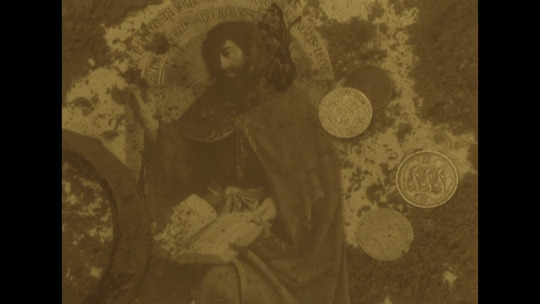
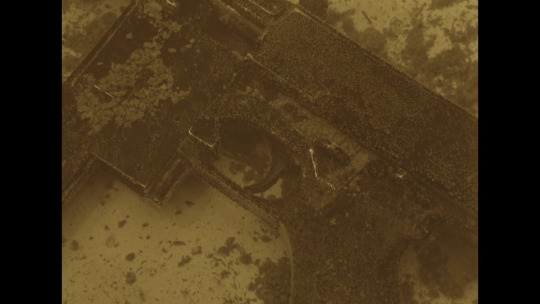
3 notes
·
View notes
Text
Torture in Fiction: 1984
I got an ask about my opinion on torture in 1984, the best way to address it seemed to be starting off the media analysis Masterposts. Possibly the most famous dystopian novel in the world, 1984 is set in a fictional ‘future’ where the citizen’s every word and moment is recorded and scrutinised by a brutal totalitarian state.
Orwell’s story about the ordinary Winston Smith’s desperate struggle for some sort of emotional freedom has informed the Western world’s view of totalitarian states and torture since it was published.
I first read this as a kid and I remember it feeling incredibly profound at the time. Reading it again knowing what I do now instead of taking Orwell’s word for it…..it doesn’t add up.
But that isn’t for lack of effort on Orwell’s part. I can see to much larger extent reading this now how Orwell’s journalism fed into the way he wrote this story.
Unfortunately without anything beyond interviews to go on, without analysis, without statistics, Orwell fell for one of the oldest tricks in the book: he believed the torturers’ hype.
I’m rating the depiction and use of torture, not the book itself. I’m trying to take into account realism (regardless of fantasy or sci fi elements), presence of any apologist arguments, stereotypes and the narrative treatment of victims and torturers.
I’m giving it a 3/10
The Good
1) Winston, despite his mental posturing, is neither political activist nor lover. He is not a true believer. He is, in all important respects, an innocent. He hasn’t done anything. He doesn’t know anything. And that makes the ease with which he ‘confesses’ and the information he spouts realistic. Winston has nothing to protect and every reason to believe that making things up will help his case.
2) Orwell’s depiction of sleep deprivation, relay interrogation (the Party men shouting at Winston or questioning him for hours at a time until he breaks down in tears), beatings and electrical torture is on point. This especially is where Orwell’s work as a journalist shines through. The descriptions of humiliation during relay interrogation, phantom pain from stress between torture sessions, the searing pain of electricity and losing track of time in a windowless cell. These all read like they could have come from interviews. And on these points, things that were actually happening in Russia while Orwell was reporting, the book is incredibly, shockingly accurate.
3) The way Winston loses track of time is completely true to life. And it ties in with the tortures he’s shown to go through early on. His disorientation makes his account difficult to decipher in places. It makes it difficult to tell what happened when, which tortures he was subjected to when and what was real versus what was in his head. And that is true to life. Winston’s disorientation, confusion and memory problems are exactly the sort of thing that makes prosecuting torture difficult: victims rarely know how long they were held or what they went through when.
4) The rats, according to Rejali, were based on an actual method of execution by torture. Which is a level of research I appreciate.
The Bad
The fundamental problem is that Orwell seems to have taken what torturers say as fact. The book shows torture working and it shows torture achieving things that it is incapable of doing. I don’t think this is exactly Orwell’s fault, the statistical studies and research on pain I’m drawing from weren’t done until decades after he died.
But he believes the hype; he shows it as if it’s fact. Particularly-
1) Torture does not change hearts and minds.
2) Personalities can not be rebuilt using torture
3) Torture does not ‘break’ people in the way torturers seem to imagine it does. It does not have predictable results and it does not have the same effect on everyone. The systematic way the Ministry of Love ‘breaks’ everyone who comes through their doors is fundamentally impossible
4) The extent to which the torturers know about Winston’s life is impossible and absurd. Even if they somehow had the manpower to watch and listen to every second of his life and intently scrutinise every moment they would not be able to judge his thoughts at any given moment with the accuracy that they do.
5) Winston’s torturers are supremely good at detecting when he lies. And human beings are terrible at detecting lies. The degree to which the torturers seem to be able to read Winston’s mind is really more at home in an X-men comic than anywhere else. Because without telepathy what the book shows is impossible.
6) A lot of the torture that goes on in the Ministry of Love appears to be high tech, drugs, complicated machinery and the like. Doctors usually seem to be on hand and assisting. This rarely happens in real life. If something is complicated enough that it requires a specialist to operate than it generally isn’t used in torture.
7) The ordering of Winston’s torture doesn’t match the general pattern I see in accounts and analysis. Torturers don’t tend to wait around. They generally use as many of the worst things they can think of in the first 24-48 hours. They may keep torturing beyond that point but they generally repeat themselves after that point and after a while lose interest. In contrast Winston is left alone, possibly for days, before he’s even beaten. Then he progresses from beatings to relay interrogation to drugs to electricity to ‘Room 101’, going to progressively worse and worse tortures.
8) Torture destroys Winston’s affection for his lover. I’m not convinced by the narrative that the affection was all that deep to begin with but- that isn’t something torture can do. The idea that wounded people are somehow incapable of affection seems particularly horrible to me: it’s something torturers tell victims but it is not true. And it seems to perpetuate stereotypes about the mentally ill.
Overall
It’s difficult to blame Orwell for the glaring mistakes in this book when he was working with the best information he had at the time.
But looking back over this book I can’t help wondering how much this has fed into the stereotypes about torture we see in fiction today. Because most of the usual suspects are here:
The idea that everyone ‘breaks’. The idea that torture is high tech. The idea that it’s scientific. The idea that torture can fundamentally change a person’s beliefs, thoughts and feelings. The idea that torturers can recognise lies easily. The idea that victims are forever defined by their torture.
I don’t think these all started with Orwell, but he seems to have codified them and popularised them.
They’re made to look more plausible by being interspersed with descriptions that are accurate. They’re woven together so seamlessly that the two are difficult to pick apart. It’s jarring to see such vivid, accurate portrayals of Soviet torture techniques next to things that are flat out impossible.
In the end I think it’s a shame. 1984 is a book that gets a fair amount really, really right but it’s outweighed by the sheer scale of the things it gets so wrong.
Disclaimer
#tw torture#Masterpost#media analysis#1984#relay interrogation#sleep deprivation#beating#electricity#high tech torture#stereotypes about torture#Soviet torture#torture in fiction
181 notes
·
View notes
Text
ART4002 - Mollerup
How does the materialin Mollerup’s text help you to think about the ways in which your linguistic and non-linguistic material is interpreted by your audience? Think of your own creative work. How do you use language and non-language in your own work and why? What are the key semiotic devices (linguistic and visual) used in design relating to sustainability and ethics; human emotion and social issues; story-telling and narrative devices?
In Mollerup’s text, the author explores the relationship between objectivity and subjectivity. He states that ‘Referential and emotive functions often oppose each other and they are inversely proportional in many circumstances. The more objective a sign is, the less objective it is and vice versa’. When creating a comic strip therefore, this notion helps to harmonize the exoteric image with the supporting dialogue or caption.
When applying Roman Jackson’s communication model (1960) to any comic page composition, the adresser’s role is to illustrate a clear and objective message through action, emotion or facial expression, body language, colour, line, placement or shape. Once an effective image sequence is finalized on the page, the supporting text is used to refer to specifics in dialogue and narration, changing in accordance with panel. For instance, the following excerpt from my comic Jimmy’s Vendetta displays this in a simple conversation between two characters:
Panel 1 Chronos puts his arm around Jimmy looking at him happily.
Jon Chronos: Jimmy, you may not be my biological son, but you were always a son to me. I’m very proud of you. Jimmy: Thanks Jon.
Panel 2 Chronos goes to open the door for Jimmy to leave.
Jon Chronos: I mean it James, keep it up. You’re going to be my best man one day, I know it. Jimmy: I aim to please, see you soon!
In essence, with little to no effort, the addressee should be able to grasp the trajectory of the story whilst glancing form one panel to the next, irrespective of text. Upon adopting this simple hierarchy, both the emotive and/or the conative messages are therefore achieved.
On the other hand, unsuccessful sequences tend to fail when drawings do not display a careful consideration of both time and space in relation to one-another. For instance, in my first comic named ‘Seres’, I had introduced a scene with the first panel depicting a cold mountainous region, only to immediately cut to a medium close-up of a desert scene whereby four men are riding on horseback. My initial intention sought to show the journey across a great distance however, a lack of transitional panels seemed to eradicate time between the two places. In turn, both the scene itself and the character relationships became rather insignificant and somewhat arbitrary. Overall, my tutors, fellow students and ordinary readers tended to appreciate my drawings as individual illustrations, but failed to see how one panel had informed the next. It finally hit home when my tutor Woodrow said “Comics is not about not about making pretty pictures, its about learning how to tell an effective story’. Since then I have carried this principle forward growing in confidence and ability with every comic book creation.

Jimmy’s Vendetta Concept Sketch (2019)

Watchmen (1986)
Mollerup summarises many of the key technical terms used in semiotics. Select two or three of these technical terms and use them in discussion of your own work. You can choose any aspect of the Mollerup text that is relevant to you. [You may find the following sections useful, but you don’t need to restrict yourself to these terms. Link to anything that seems relevant to your own work: Jakobson’s Six Factors of Communication (p.75); Signs (p.78); Codes (p.80 - 82); Icons, indices and symbols (p. 84-85); Practical requirements of trademarks list (p. 90-91)]
In Mollerup’s text, Pierce’s ‘three-part division of signs into icons, indices and symbols’ is the most relevant concept when discussing the practice of narrative illustration. Category 1.1 defines images as ‘highly representational signs that look very much like their object.’ In essence a graphic novel comprises of a sequence these images, which read together in an orderly fashion to tell a story.
In my current Final Major Project titled ‘Jimmy’s Vendetta’, I use images to represent a fictional cyberpunk realm, which feels visually grounded in reality. In order to achieve this ‘look’, drawing both from life and image is essential. I habitually draw people, objects and surfaces, and cityscapes. In addition, I collate images of Tokyo, Samurai armour, Italian Mafia suits, and ancient Greek architecture to study from. Lastly, I read the visual styles of other western comic artists in order to analyse their drawing techniques. In particular, Jorge Zaffino’s heavy inking style in The Savage Sword of Conan depicts a harsh noire mood, whilst Placensia’s luminescent colouring style in Batman Zero Year screams ‘neon’. A perfectly balanced combination for my moody hi-tech dystopian future.

The Savage Sword of Conan (1989)
In harmonizing these elements to produce my final outcome, the image will serve as the window with which the viewer sees the fictional world. I hope to effectively synthesize the traditional stages of drawing, inking and colouring so as to convince the viewer of a physical space that could exist somewhere in the not-so-distant future.
0 notes
Text
Ruin
Welcome! I'm currently in the GTA for the weekend, slash-pleasure-slash-business. I went to The Artist Project show in Toronto in support of my colleagues, and it was an interesting space! Definitely a lot of talented folks, and it was good to note patterns and trends going on right now in the art world. I also got the chance to pick up the laser-engraved iteration of the Lonely Hydra and I'm so excited to print off of it when I'm back in London! It'll be great to compare it with the vinyl-cut and blasted iteration I worked on a few weeks back. I am a little caught up up here to I can't sit down and take pictures, so stay tuned to my instagram to see what's up. In studio news, I've been currently working through the prep for a project! Made a rubber casting of a clawring I picked up someplace, then made my own iteration for a bigger project, down the line. I'm basically making digits for Death's gauntlet, and I plan to make a series of sculptures of holding symbolic items. I was considering casting the components in either pewter or impact beads! But I will expect obstacles to block my path and delay things. This past week is a testament of how I haven't had a chance to sit down and work digitally for the online shops, let alone anything else. I'm hoping there will be a lull in life real soon or else I'll have to start brushing people off. Life of an artist. So, in the last two blogposts, I discussed the base concepts that fuel my creativity, and now we'll connect them to the contemporary. I will preface and say that I may not be consistent or very clear with my ideas because when it really comes down to it, it's the aesthetics that matter most to me. But I'll give explaining my reasoning a real try! Concepts such as the sublime, hope and despair, and a graceful death still carry over into present day. Confronting fear and pain through art embodies a form of the Romantic sublime, one that questions our survival of the terrors of ourselves. A contemporary realm that does his is Anthropocene art. The term Anthropocene describes our time period, dating back to the moment Earth started showing significant symptoms of humanity's influence. Our lifestyle and its harmful consequences evoke creative minds to speculate potential dystopian outcomes if these problems persist. Artists who choose this topic as their focus often emphasize disastrous side effects (such as environmental pollution) and display them as shockingly beautiful things, so beautiful to the point it nurtures fear. They offer a reality check, if you will. Post-apocalyptic settings in media often focus on the people living in the aftermath, and they usually depict them having adopted a regressed lifestyle. To me it relates to the cycle, or coil, of hope and despair. It's not necessarily a clean slate, because it can't quite exist like it had when time began. There would be people remembering what life was like before a calamity, as opposed to previous events spanning millions of years. As a coil, things repeat, but not in the same way. The fantastical narrative that attracts me, however, is a world withstanding some great equalizing event that make all other political affair or corporate conquest irrelevant. Everyone is in the same boat trying to survive in a familiar yet ultimately changed landscape, forced to adapt. That's what every other creature on this planet's had to do to co-exist with us, so it serves as a fruitful allegory. It's like the people who survive the event are a different kind of species from the people that existed before; more raw and simple, even though they could have existed in both times. I dunno if any of that makes sense, since I usually refer to urban ruin more as a form of aesthetic than philosophy. The storytelling behind the scenes I delve is all up for interpretation. I get cautious talking about the people-side of things because it can sound a little political or preachy. Like, I've always had this innate opinion that the greatest threat to man is man itself and that our hubris will be our downfall. It's happening as we speak in the form of climate change. But yadda yadda, what about it? At this point it's a very common mindset, and I believe it can be quite pessimistic and selfish to think that way. We shrug off the responsibility when we chatter and say it's up to the big corporations to take action, and it may well be beyond us, but it becomes a whinging dirge that jumps from one generation to the next. Our attention span is too fleeting, and those who remain focused, or 'woke', end up consumed by their loneliness and hopelessness. But despite the name or politics, most of the works in the Anthropocene realm that draw me lack any human subjects; the scenes are strictly describing what the world looks like in the absence of people, with only ghosts of their promise remaining. Urban ruins are my aesthetic. They exist in the wake of destruction, victim to some great, terrible, sublime event that rendered them asunder. Then there's a stillness, a peace, a spirit. When life still persists in the wake of death, oof! It's very pretty. The Japanese isle of Hashima, the documentary series After People, the far future in Cloud Atlas, the forbidden lands in Shadow of the Colossus. I don't expect anyone to get all of that when they look at my work. I'm more interested in the spirit that exists in these landscapes. Romantic painters flocked to ruins as a subject since there was something seductive about their downfall and the memory left by their inhabitants. That really resonates with me, too. Angular bricks overtaken by flora, fauna constructing dens or nests in the nooks of broken structures, why, there is no final death there. Death occurred, and it's the end of someone or something, but not the end of all. At this point I feel I've just word-vomited everywhere, but long story-short, I like ruins. They are sad, yes, but they heal overtime. Scars are beautiful. Contemporary media takes it up a notch and we get breathtaking visuals that drive the relationship between man and nature home. Urban ruin. Post-mortem beauty. A beautiful death. We are destructive as a species and we should do everything we feasibly can to reduce our mark. If not for us, then for everything else after us. Our world is in constant battery so it doesn't have time to heal, so any effort helps it catch up. I want to see more healing. ... Okay that's enough! It's about time we get to the craft and medium of things. I can't promise concepts won't slip in here or there but at least you get to SEE something right? Until next time! Gosia
0 notes
Text
But I’m a Cheerleader
Avatar image thenightetc User joined room 22:50 Avatar image thenightetc Hello! 22:50 thenightetc here 22:51 Avatar image Thebes User joined room 22:51 Excellent! 22:51 Avatar image thenightetc There we go 22:51 Avatar image Thebes Present! 22:51 Avatar image thenightetc Aw, you get a little crown on yours. 22:51 11 Shirts For Marbles' 11th Birthday 22:52 Avatar image Thebes I can't even judge, I spoil my dogs like all hell 22:52 How dare you accuse me of dressing Impact's pandas up in little clothes?
Back! Back! Hooray! Wait, let's wait for Zepha Oh, good idea. And what a short wait it was! I'm here!! Also, word on the street is that rabbit's out of money and a few weeks from closing down. Oh, good idea. And what a short wait it was! I'm here!! Also, word on the street is that rabbit's out of money and a few weeks from closing down. Ugh of course it is Oh, damn. OH. RIGHT. I forgot about this. Something about my extensions/ad-block won't show the video on my end, just the audio Awww, no. Try another browser? I can only watch rabbit in chrome I tried that last time too, it wouldn't work on Chrome OR Firefox Last time I just had two of me in the room, one on the laptop and one on my tablet but my tablet's been dead for months Oh, damn... Oh, damn... Can you open the movie itself in another window and have both on at the same time? Lemme try Firefox again That's what I would do when livestream was so persistently bad NOPE. SAME DELIO Audio, no video UGH Do you want the timestamp? nah I'll figure it out. I'm gonna see if it'll work on my phone If you're sure! don't wait for me, I'll be fine! oh! subtitles! ALRIGHT I GOT IT Woo! Wonderful! Tiny screen but at least I can watch!! What a charmer. Honestly I come to these streams more for the company, commentary, and the lot of us joined in solidarity of our mockery/horror of the movie to begin with Could you turn the subtitles back on? Gladly. Sometimes it's a little hard to hear Thanks! Aaaand they're not synced. Yyyeah, never mind, then. Because Unicron forbid anything work tonight. ugh drives me NUTS when they do that I hope that's not how they announce that somebody's dead I am going to rip off my array and throw it at the wall. wait why are they doing this already I thought she was still in the closet at this point how would anyone know? I don't even think she realizes it. Is that her boyfriend there? wait... wow ... they brought in a conversion therapist based ENTIRELY on stereotypes??> Is that her boyfriend there? wait... wow ... they brought in a conversion therapist based ENTIRELY on stereotypes??> Apparently! Thread-THIN stereotypes??? wtf the irony of their logo having a rainbow in it Kelly looks fun. right? Gah. How do humans live like this? Wait is that Melanie Lynskey? HAH We don't yeah, even the state that created this kinda camp shut down all theirs after a few (horrible) decades 'Alright that's too much affection tone it back a bit' poor kid. Graham has absolutely no intention of giving into this life I mean, give into this life and it's a slippery slope to your life resembling 'Saving Christmas' ... gender identity and sexual orientation ARE NOT THE SAME THING MAN .... This was all so inevitable. of course actual conversion therapy is a legit dystopian torture-chamber nightmare Oh, no. Pants. A true nightmare NO PLEASE ANYTHING BUT THAT Yeah, why would they want to watch a bunch of sweaty, muscular men grappling with each other The time I watched my uncle watched UFC I commented after a few minutes 'wow this looks super gay' and my uncle FREAKED OUT AT ME FOR IT y'know the FIRST mistake was pairing these kids with a same-sex friend obviously feelings are going to develop in this atmosphere I mean, obviously They're the world's best matchmakers. LOLOLOLOL awwww ah ah ah a REAL lady does not CROSS her legs she only keeps her knees together, sometimes hooking her ankles together if she needs it awwwww awwwww TEMPTATION ohoho fake IDs! This is adorable. 'and then I realized dancing with that OTHER girl didn't make me happy and watching graham dance with a girl made me ANGRY so maybe there's hope for me!!' 'Oh wait no n/m' It's hard to resist sweet as pie. I certainly couldn't. Oh wow the actresses actually looked into it there's way too many actresses playing lesbians/wlw that look like they're obviously forcing it for the job jesus. god this movie is a nightmare It really is. honey no don't bring out th eblacklight *blacklight Ohhh dear psh he can't even say it Field trip to the Cocksucker, class! ...Wow 'YOU'RE choosing to cut US off' uGH Hah! 'Look how heterosexual we are' gah, creepy GAH yes let's put these underage teenages in sexual situations not creepy at all you girls gonna get snitched on d'aww this is the sincerest thing I've seen in this movie sofar :< :< uGH *SHUDDER* UGH. I can't get over this, adults forcing kids into this is so skeevy it really is Wait... That's Dante Basco!! HAH Nice And Mike is RuPaul. Wait WHAT Oh my god I didn't even recognize him at all Wild Isn't it? How did she not see THAT 'I can't lose daddy's money AWWWW HER PARENTS ACCEPTED HER AFTER ALL Awww! Well, good Even if the mom needs some more time She made it there, she'll come around. Progress is progress Well that was a thoroughly uncomfortable ride Humanity's hang-ups are a trip, aren't they Knock Out? A thoroughly uncomfortable trip! Let me dig up our light note. Yes Oh gosh yes please Yes, let's! I need a palette cleanser Wait this movie came out in 2000?! I mean judging by how young some of the actors I KNEW are I knew it had to be slightly oldre *older but I first saw the internet going crazy over this movie like, 2015 or so So I assumed it came out in 2010 or around that area at the EARLIEST noooope. but to be fair, you have to cast back to 1991 to find depictions of conversion therapy that... well. That. hashtag YIKES wooooooooow Ha! I like this girl Her sense of humour feels trustworthy god Jesus. (slowly looks at camera at that conclusion ) 'If you're unhappy about the quality of the video you just watched, complain to metro they'll write about it' AMAZING And one more quick one to really kick off pride month... I'M CRY ooh yes AHHHH YES what the fuck AHAHAHAHA ... ooh that's one thing that's nice about rabbit too I can CUSS I used to have to sensor my own cussing on Livestream Appalling. if I typed 'fuck' I'd have to type 'f*ck' or it would come up '****' Censorship just fucks everything up. Yes. Rabbit may be a butt that's about to die but at least we can say fuck Cling to that spar and don't let go. ALWAYS Yeah, the row of ****s just like... draws extra attention to it It makes it look worse! That's why I got into the habit of censoring myself Everyone knew EXACTLY what I was saying THAT way Well--as always, thank you for the stream. And thank you for coming, as always! It was certainly... a thing that's for sure! thanks for the stream! It's always wonderful when you can make it, zephra human. I'm glad I could today, my work schedule's a butt but say high to Breakdown and Impact for me! *hi Of course! Good night, everyone! Goodnight! 'Night guys!
0 notes
Text
#007 - A Death in the Family, by James Agee

A Death in the Family plays out like an inverse to Let Us Now Praise Famous Men. Now, they aren’t all that different; both of Agee’s masterworks examine the construction of the American family through an encyclopedic attention to detail. Where they diverge, however, is in what aspect Agee chooses to focus his exhaustive eye on. In Let Us Now Praise Famous Men, Agee writes a book based in place. He moves from room to room in the subject families’ houses, describing everything inside these rooms, hoping to build as diegetically complete of a scene as possible for the reader. When time factors in to Let Us Now Praise Famous Men, it is cyclical and at the service of place: how does the time of year factor into what these houses look like, how the family operates, what these objects are used for? This is a book that will spend a dozen pages describing a chair, but isn’t interested in explaining why someone is sitting in that chair, or what they may be thinking about.
Time is the aspect that Agee centers on in A Death in the Family. A Death in the Family, first and foremost, is a narrative work in a way that Let Us Now Praise Famous Men isn’t (nor should be.) The novel depicts the events leading up to and immediately following the sudden and traumatic death of the family patriarch, Jay Follett, in an automobile crash. It takes us back and forth in time through flashbacks and changes in narrator, but primarily operates as a linear timeline of the minute decisions and thoughts and actions that every member of the family makes during this tragedy. Agee inhabits the members of this family as they interrogate every decision they make: Jay ponders whether to wait until morning to get back in his car, whether to let the children know where he is going, and so on. Every decision by every character leads to another decision, another action, and Agee follows each of these strands so that each character, even if they are not acting in a completely rational way, is so fully understood by the reader that our level of empathy (to use that oh so debated word) is elevated to transcendence.
Time remains unignorable. After the accident, each of the decisions that the characters must make comes with the straining pressure of time. Mary, Jay’s wife, along with the rest of the adults, must quickly determine how to sensibly let the two children, Rufus and Catherine, know that their father wouldn’t be coming home, and the adults know that they only have a few slivers of time before the kids would trounce out of their bedroom, anxious and excited to start the day with their ma and pa. A Death in the Family clearly presents how each decision is made within a temporal framework, and cannot be redone, retracted, or rejected once it has been made.
Agee, taking as his aesthetic cause the reasons why people make the minute decisions that they do, gives himself a challenge by focusing on these characters. Mary, the mother, is a grieving widow who is absolutely reeling in the hours and days after finding out her husband is dead. The ‘grieving widow’ archetype is the person granted the most illogic in their acts in our society; no one would look at a person like that and demand the reasoning behind their actions and their coping methods, but Agee manages to imbue even these with an understanding that moves beyond pure logicality or uncomprehending sympathy. Likewise, Agee devotes much of the narrative to the perspective of young Rufus (the author surrogate if there ever was one), who, as a child, still does not completely understand the relationship between causes and effects. In this way, Rufus explores and tests boundaries, often causing distress among the other family members (especially his sister, the only person in the family he can exert some level of control over). James Agee examines and depicts Rufus’s thought process in a similar way as any of the more fully-formed people in the family, managing to neither ‘talk down’ as Rufus nor obscure his own internal logic.
Overall, I loved both Let Us Now Praise Famous Men and A Death in the Family. They both left me yearning for an Agee that did not die so young, who could have written exquisite prose in both fiction and nonfiction for decades longer, producing these texts that so accurately and heartrendingly capture what living is. In that way, the novel unfortunately mirrors our reality: the father is gone too soon, and time marches on.
Other Books Read in the Interim
Antígona González, by Sara Uribe
The Revenge of Analog: Real Things and Why They Matter, by David Sax
Camanchaca, by Diego Zúñiga
Fever Dream, by Samanta Schweblin
Wicked Weeds: A Zombie Novel, by Pedro Cabiya
Cheer Up, Femme Fatale, by Kim Yedeum - A rebellious and remarkably accessible (for a poetic work in translation) collection of poems that conjure traumatic and erotic moments and intermingle them. Deftly manages to be irascible, humorous, sexy, and mournful at once. Recommended.
Nine Island, by Jane Alison
Tell Me How it Ends: An Essay in Forty Questions, by Valeria Luiselli - If I had a couple spare billion dollar bills around I would use them to buy a copy of this book for every household (and apartment and shelter and barracks and every other living situation in America) and mail them out with a post-it that reads: "Please read this short book. It will probably take you less than two hours. Tell someone how you feel at the end.”
The Idiot, by Elif Batuman - Disappointing, but not awful.
Lowly, by ALan Felsenthal - I appreciate the coyness in which Felsenthal deploys his humor here. The first couple poems seem rather staid, heady exercises, but then you find yourself reading slippery rhymes aloud. Overall a great collection that matches Felsenthal's curatorial savvy at The Song Cave.
Building the Barricade, by Anna Swirszczynska - Important witness poetry that unfortunately reduces itself to simple moralizing at times; there are poems in here that seem a little too "neat." This works to make the less constructed poems even more impactful, however. And who's to say? Maybe even war can have a sense of ironic righteousness.
Megg & Mogg in Amsterdam, by Simon Hanselmann - I never expected a cartoon bird’s beak being broken off would be such a traumatic image, but it makes sense. This is a pretty fun, disturbing collection of vignettes about a bunch of slack-off stoners, except they are a witch, a cat, an owl, and a wolfman.
Of Being Dispersed, by Simone White - A fantastic collection of poems bursting with personality. Each section showcases a different style and aspect of Simone White, and it would be a challenge to find a bad turn in any of them.
Universal Harvester, by John Darnielle - Darnielle’s second novel starts off with a Stephen King-inflected premise and a great control of mood, before it kinda dissolves near the end, and ends up not really amounting to much.
L’Heure Bleue, or the Judy Poems, by Elisa Gabbert - A compelling set of poems from one imagined character that I chose to read as a single long poem, which I found to really work in the poetry's favor. As a result of the sustained perspective the poetry never gets too heady, but instead lives in a compelling narrative skeleton. I'm interested to read the Wallace Shawn play that the character comes from to see how the ghost of a world evoked in the narratorial introspection matches up to the world as Shawn conjured it.
Exit West, by Mohsin Hamid - There have been TV novels, and Internet novels, but Exit West may be the first serious contender for Best Smartphone Novel Of Our Era. Mohsin Hamid does this not by creating a postmodern-damaged tome of fragmentary narrative on How We Live Today but by crafting a small, warm story about two refugees as they move westward and try to replace one sense of home with another. Saeed and Nadia rely on their phones, as tools of contact, stabilization, internalization, and understanding. Hamid depicts how smartphones were necessary in facilitating the growing romance between Saeed and Nadia, but also shows how quickly that same technology can become a barrier between them, a way for them to turn away from each other. In between those two points, we see how powerful the draw of the smartphone is on the couple (and, indeed, 'all of us') in its absence. It is when the war escalates, and the network drops out, that Saeed and Nadia must change their relationship, take their next step, in a way that they wouldn't need to if they could still text each other.
American War, by Omar El Akkad - While some of American War feels like too 'edgy' and pat for an interpretation of our inevitable dystopian future, I appreciate that El Akkad sticks with the side of the non-righteous: a conflicted, broken biracial woman from the south who just wants to destroy the north and everything they stand/stood for. It's too easy to imagine a take on this same future that stakes itself in the comfortably liberal mindset of an intellectual northerner-type that bemoans the waywardness of the backcountry southerners and their backwards values. Instead, we get something a lot knottier, a lot more painful, and maybe even more truthful.
All The Lives I Want: Essays about My Best Friends Who Happen to Be Famous Strangers, by Alana Massey - An interesting collection that examine celebrities and their allegorical importance, All the Lives I Want by Alana Massey still falls prey to some of the issues that tend to bog down essay collections. Namely, some of these essays were very surface-level, and could have dug twice as deep and gone on twice as long. There are plenty of insights to be found, whether they be about Anna Nicole Smith's 'immigrant narrative' or the perception of Amber Rose among the stripper community, but some didn't say much of anything new. Nonetheless, Massey's authorial eye is compassionate and intriguing, so I walked away from this book rather delighted overall. The first essay "Being Winona; Freeing Gwyneth: On the Limitations of Our Celebrity 'Type'" was the definite highlight for me, so test out the waters with that one if you are curious.
The Correspondence, by J.D. Daniels - This little thing right here sure is enigmatic. Dropped in early January (where it seems a lot of literary publishers like to offload some stuff that even they don’t know how to market), The Correspondence isn’t maybe as mindblowing as the declaratory minimalism of the packaging would have me believe but I still find it an appealing little autofiction.
A Simple Story: The Last Malambo, by Leila Guerriero - I quite enjoyed this sports comeback narrative by way of journalistic endeavor, about the small but intense competitive dance world of Malambo, something I didn’t know much about before reading this. Perfect for a sunny day at the beach, where you can lounge around and read about other people exerting their bodies to the breaking point.
I’m an Old Communist Biddy!, by Dan Lungu - Absolutely astounding. I think I could pick up any Dalkey Archive book and be blown away by it.
The Rules Do Not Apply, by Ariel Levy - A solid 3.5 stars for this harrowing memoir about how quickly a life can fall apart. Ariel Levy writes compellingly and depicts her narrative interestingly, but can be a bit obtuse at times (what you might see elsewhere described as "unexamined white girl privilege"). I think this work is most interesting as an exploration into how comfortable we (especially as westernized, neoliberal/neoliberal-adjacent subjects) can get in our lives even when we are confronted with signs of disaster and doom everyday. For Ariel Levy, it's some of her or her partner's behaviors, such as infidelity and alcoholism, but an overarching metaphor could be constructed. Sometimes it’s the disasters you see and ignore that bring ruin, sometimes it’s something completely unexpected, and frequently it's a chain reaction of both.
Imagine Wanting Only This, by Kristen Radtke - Imagine Wanting Only This is a graphic memoir that doesn't say that much and shows it in a way that reflects that. Perhaps I just didn't hit the same wavelengths as Radke does, but I found the memories presented to be formless and sometimes lacking in detail, which could be credited to the smooth and flat illustration style. That being said, I don't have anything against Imagine Wanting Only This either, and could understand why it is connecting with certain audiences.
The Market Wonders, by Susan Briante - Maybe the most powerful 'fuck' in our contemporary poetry. So good.
Hope in the Dark: Untold Histories, Wild Possibilities, by Rebecca Solnit
Letterman: The Last Giant of Late Night, by Jason Zinoman - A reverential but unflinching look at the man and his neuroses, as well as the comic figure and his importance in the greater narrative of American comedy and television. Worth reading if your dad loves Letterman like mine does.
White Tears, by Hari Kunzru - One of my favorites of the year so far, a novel that I haven’t completely wrapped my head around. One of the best horror stories put to paper in this decade.
The Feud: Vladimir Nabokov, Edmund Wilson, and the End of a Beautiful Friendship, by Alex Beam - This piece of nonfiction lays out the academic gossip in an easy to read style, but I found it a bit redundant. If you are a Nabokovite, then you know this story (if not all the details) and if not, what is there for you to really care that much about? I don’t know if this book gets all the way to its justification.
Four Incarnations: Poems, by Max Ritvo
The Book of Joan, by Lidia Yuknavich
South and West: From a Notebook, by Joan Didion - While South and West is somewhat of an obvious cash grab by publishers hoping to juice out additional content from Didion, this isn't a Watchman scenario, as South and West reminds us of Didion's absolute craft and talent in the first place. I bet that some aspects of how Didion writes about the south could rub people the wrong way, in that it is more than a bit classist, but it is also an accurate portrait of a particular mindset of the late 20th century that still abounds today. Overall an insightful look into the process of one of our greatest writers of nonfiction.
Zeroville, by Steve Erickson - I did quite enjoy Zeroville, but at times it felt like a conversation in which the other person tries to cite as many movies as possible just to show off.
The Aisles Have Eyes: How Retailers Track Your Shopping, Strip Your Privacy, and Define Your Power, by Joseph Turow - The horror reference in the title is accurate, but the book rejects any overt fear-baiting.
Disgrace, by J.M. Coetzee - My first Coetzee, and it lives up to the Nobel. I didn’t know it was essentially going to be a French Extremist film set in South Africa, but I love it.
Scald, by Denise Duhamel - I wish I could give this a bit of a higher rating, as I basically agree with most of the sentiments espoused in this collection of poetry that centers on feminism and ties together the lives of Shulamith Firestone, Andrea Dworkin, and Mary Daly. The issue for me was that many of the poems felt a bit too didactic. That said, they can still be quite playful and entertaining.
Marlena, by Julie Buntin - I oscillated between a 4 and 5 star review on this one. Buntin takes a familiar story template (person reminiscing on a fateful, possibly calamitous friendship that colored their entire existence from then on) and imbues it with such a powerful sense of mood that the effect of the book becomes undeniable. Cat, the somewhat nerdy daughter of recently divorced parents, moves to a resort town in Northern Michigan and befriends Marlena, a fiery force of personality who is enmeshed in a rather troublesome life (drug addiction, preying older men, an absent father). Cat becomes obsessed with Marlena and their friendship, and for a while the book threatens to be a female friendship twist on a dream girl narrative, in which Marlena pulls Cat out of her anxieties and such and shows her how to live before disappearing. Thankfully, Buntin creates a narrative that is knottier than that, and we are given a truly felt, as in emotionally, piece of fiction, one that doesn't resolve itself so neatly in the end, even if we know what's coming from the beginning.
Eleven Prague Corpses, by Kirill Kobrin - What can I say? Another Dalkey, another masterpiece!

0 notes